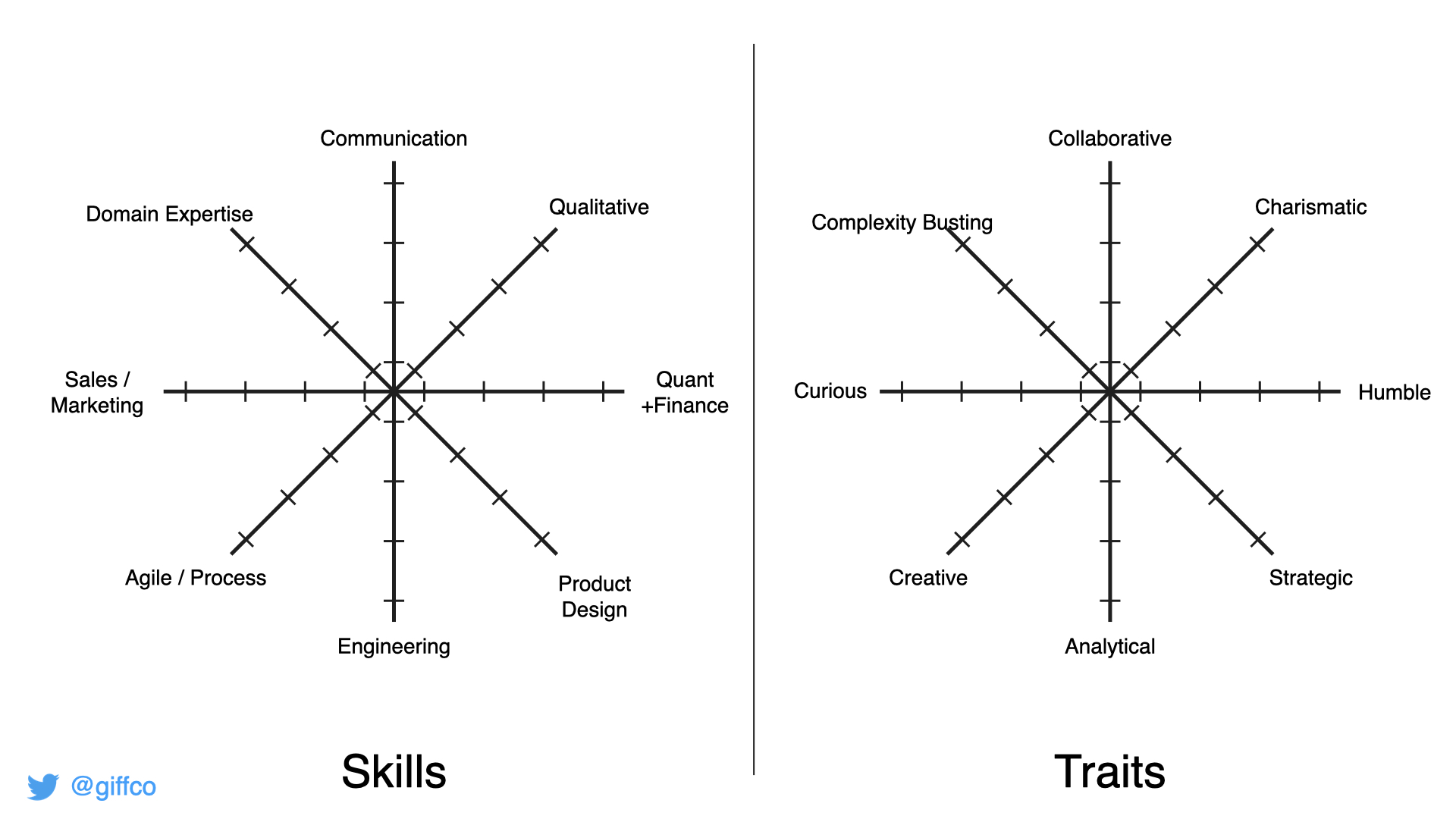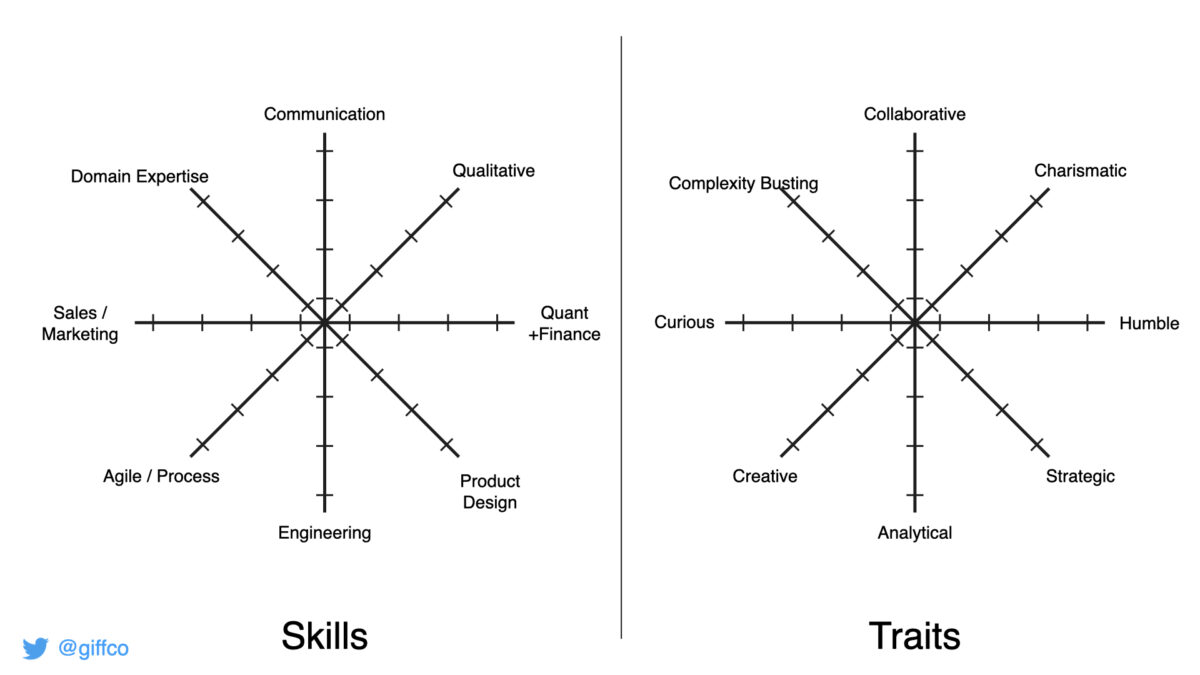A year and a half ago, I gave a talk to the New York Product Conference about the Associate Product Manager (APM) program I started to put in place at Meetup when we were 200+ employees. This week, I caught up on Clubhouse with Tommi Forsstrom, who runs product at Teachable, about the APM program he has put in place there. As always, Tommi helped me improve my own thinking on this topic, so here is an updated take on APM programs.
What is an APM program?
It’s a training program that creates an on-ramp into product management. More tactical details are below.
Why do an APM program, and why in particular an internal transfer APM program?
It’s extremely challenging to hire junior PMs, primarily because it’s so difficult to interview for the key traits, as opposed to the skills, a person needs to do the job. What do I mean by traits?

That said, there is an amazing group of people who have the potential to become great junior PMs, and where you have an inside track to detect their PM-awesome traits. I’m talking about your fellow employees in other departments.* Even more amazing, these are people who have already opted into your company’s mission, they already know and care about your customer, and you have an inside track to detect their PM-awesome traits. And even more amazing, this group often offers a level of diversity you are probably hungry for in your product organization.
While I would definitely hire an APM from outside the company, they would need to have at least some work experience, and I would look to hire internally first.
*Side note: while places like customer success, business analysts, user research, product marketing, and engineering are classic places to look, other ones include ERGs where someone is showing leadership, or even those talented “rovers” who haven’t quite found their place in the org, seem to be good at every job but haven’t found the right one, and who could be perfectly suited for a multi-disciplinary job like PM.
Before you set up a program
First of all, you need to ensure that you have the budget for one or more APMs. Second, that you have a culture that supports internal transfers (some companies love creating opportunities for their people, but sadly in others managers can treat this like “poaching” and be quite hostile).
You have to decide up-front how you will handle: 1. salaries; 2. people who leave or don’t make it in the program. If someone makes less than your target APM annual salary, I would not change their base pay but rather create a bonus structure that gets them to an APM level while they are in the program. Once the candidate becomes a junior PM, their title and salary would be official. Note: if someone makes more than an APM, this is usually because they are more senior, and I don’t think the APM program would apply to them. See the bottom of this post for my thoughts on this scenario.
For those who start the APM program but whom you don’t think are a fit for junior PM, you have to decide a very big question: is their old job waiting for them? You need a clear policy — do not do this on a case-by-case basis. My current take is: they can only get their old job back if the position is still open.
In other words, if they choose to leave the program, or you decide they aren’t a fit, and their old job is now taken or gone, you might be talking about the company parting ways with the person.
You need to be crystal clear and transparent about how you will handle such a situation. Your heads of HR and Finance need to be onboard, and the people considering the APM program need to know the policy. They have a right to know what they are getting into. There’s always risk involved in changing jobs, but please help them make an informed decision.
Scouting talent into the program
I believe in an invitation process, rather than a formal application process. That said, all of your employees should know that they can raise their hand to be considered for the program.
There are a few steps that go into creating an invitation process:
First, create opportunities to spot talent. Some ideas:
- Run open-door demo sessions and see who shows up and asks good questions.
- Have teams run design studios or other forms of co-design sessions with other functions in the organization.
- Create ambassador programs where other groups (customer support, marketing, sales engineering, etc) can put forward someone to interface with the product function
- Run cross-functional hackathons and see who shines with energy, creativity, and the ability to pull together and influence a team
- Set up open office hours on topics like roadmap prioritization
Second, educate your PMs and designers (and even engineers) on the traits you are looking for: curiosity, passion, creativity, ability to lead a room, humility, etc. Explicitly state that PM traits matter more than PM skills for consideration. And also explicitly state that you are looking for people from diverse backgrounds.
Third, once a potential talent is scouted and before you approach the candidate to see if they have any interest, get permission from the executive owner of their current job function. Don’t create a political mess for yourself by skipping this step. You might have to navigate issues around timing. However, one thing should remain firm: any candidate in the APM program has to be full-time; they can’t keep any of their old job responsibilities.
If you get permission from the exec/manager, approach the candidate and test for interest.
If someone raises their hand and asks to be considered for the APM program, thank them, explain that you’re looking forward to getting to know them a bit better, and ask them to tell their manager about their interest (or give you permission to do so). If you think they are promising for the program but don’t have an open slot, be transparent.
The Program Itself
What might this program look like? I still think this should be a 12 month program, with possible early promotion at 6 months. At the beginning they would be in shadow mode, helping a PM on a team. Gradually they would start to take on more and more responsibility. Ideally they would rotate teams — probably no faster than 2 months but no slower than 6.
Tommi ran his program as 6 months: 3 months shadowing a PM then 3 months in the hot seat with a mentor PM observing. Here is one of Tommi’s lessons:
“The shadowing should’ve been rotational. PM is such a diverse craft and manifests itself different in each team / squad / pod. We should’ve had the shadowing expose the APM more to different groups. Just seeing one develops myopia.”
I would also have someone very senior in the product management function oversee the program and act as a mentor to both the PMs being shadowed and the APMs doing the shadowing, checking in regularly (no later than every 2-3 weeks).
Setting them up for success as a junior PM
The PM job, like all demanding jobs, isn’t for everyone.
Tommi wrote:
“The last hard challenge—one we’re still trying to crack—is that the baseline PM job is actually really friggin’ hard. Especially in all its strategic, autonomous glory. There’s no chance in hell a Jr. PM can succeed in that role. Nobody wants to succeed into failure.”
Here’s my take: you should only do an APM program if you can, indeed, absorb junior PMs — both financially and operationally. If I put finances aside for a second, what are the conditions that allow for a junior PM?
Look across your portfolio of work:
- Do you have something that needs to get done, but is less demanding?
- Do you have an area that is so demanding that one of your seniors could really use some help? (i.e. let the PMs pair)
- Do you have some engineering or design leads who would be game to take a junior PM under their wing, help them level up, and yes, cover for them at the beginning? (it is okay to ask them to do this!)
- Do you have a VP/Director who can handle a bit more hands-on mentoring while you all work together to get this new PM really flying?
Having strong guardrails can help a junior PM thrive. This includes a coherent product strategy and high-level roadmap. It also includes clear product, design and engineering values about how each craft likes to approach its work. Lastly, it obviously helps to have a supportive culture where senior people lift up the juniors around them.
What about more senior people hoping to transfer into product?
I don’t think an APM program works in this situation. From a salary and title perspective, a big demotion is unattractive and often fiscally unfeasible. That said, in theory, a strong senior candidate should have a much faster learning curve than your typical PM. I’ve had both successes and failures in doing this kind of transfer.
My latest thinking is to treat this like a 3-6 month paid sabbatical, except instead of a vacation, they get to try on the new job. They get to see if they truly like the job. You get to see if their learning curve will justify keeping a higher salary/title.
You have the added benefit that the other PMs get to see this person really rock it out, thus reducing resentment at someone less experienced in product coming in at a more senior level.
You obviously needs the budget flexibility to do this, and again you need buy-in from other execs, but given how critical product management has become and how hard it can be to hire, getting this buy-in isn’t impossible.
Like with the APM program, it critical that the employee can’t get pulled back into their old job until the “sabbatical” time is done. Otherwise it is unfair to everyone but especially the employee. It’s also critical that you don’t just throw this person into the deep end but that you pair them with a good mentor/coach.
Lastly, because I’m a believer in having a transparent skills and salary matrix (see post), if someone does come into product at a salary above their true level, I explain beforehand that they won’t get further promotions until they have leveled up on the matrix.
In Conclusion
I’m a huge believer in this kind of program. Tommi expressed another thought we share really well: “Providing paths for people in non-tech functions to tech jobs is our duty for creating equitable opportunities in our field… Coaching new talent into the product space is an amazing feeling and I’d implore all the rest of you product leaders out there to start an APM program today!”
Special thank you to Tommi for advancing the state-of-the-art on this topic, and for helping my own thoughts on this topic get significantly better.
